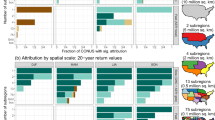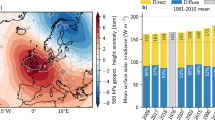Abstract
Anthropogenic aerosols in the atmosphere have the potential to affect regional-scale land hydrology through solar dimming1,2. Increased aerosol loading may have reduced historical surface evaporation over some locations3, but the magnitude and extent of this effect is uncertain. Any reduction in evaporation due to historical solar dimming may have resulted in an increase in river flow. Here we formally detect and quantify the historical effect of changing aerosol concentrations, via solar radiation, on observed river flow over the heavily industrialized, northern extra-tropics. We use a state-of-the-art estimate of twentieth century surface meteorology4 as input data for a detailed land surface model5, and show that the simulations capture the observed strong inter-annual variability in runoff in response to climatic fluctuations. Using statistical techniques, we identify a detectable aerosol signal in the observed river flow both over the combined region, and over individual river basins in Europe and North America. We estimate that solar dimming due to rising aerosol concentrations in the atmosphere around 1980 led to an increase in river runoff by up to 25% in the most heavily polluted regions in Europe. We propose that, conversely, these regions may experience reduced freshwater availability in the future, as air quality improvements are set to lower aerosol loading and solar dimming.
This is a preview of subscription content, access via your institution
Access options
Subscribe to this journal
Receive 12 print issues and online access
$259.00 per year
only $21.58 per issue
Buy this article
- Purchase on Springer Link
- Instant access to full article PDF
Prices may be subject to local taxes which are calculated during checkout




Similar content being viewed by others
References
Stanhill, G. & Cohen, S. Global dimming: A review of the evidence for a widespread and significant reduction in global radiation with discussion of its probable causes and possible agricultural consequences. Agric. For. Meteorol. 107, 255–278 (2001).
Wild, M. Global dimming and brightening: A review. J. Geophys. Res. 114, D00D16 (2009).
Teuling, A. J. et al. A regional perspective on trends in continental evaporation. Geophys. Res. Lett. 36, L02404 (2009).
Weedon, G. P. et al. Creation of the WATCH Forcing Data and its use to assess global and regional reference crop evaporation over land during the twentieth century. J. Hydromet. 12, 823–848 (2011).
Best, M. J. et al. The Joint UK Land Environment Simulator (JULES), model description—Part 1: Energy and water fluxes. Geosci. Model Dev. 4, 677–699 (2011).
Boucher, O. et al. in Climate Change 2013: The Physical Science Basis (eds Stocker, T. F.et al.) Ch. 7, 571–657 (IPCC, Cambridge Univ. Press, 2013).
Mercado, L. M. et al. Impact of changes in diffuse radiation on the global land carbon sink. Nature 458, 1014–1017 (2009).
Huntingford, C. et al. Highly contrasting effects of different climate forcing agents on terrestrial ecosystem services. Phil. Trans. R. Soc. A 369, 2026–2037 (2011).
Douville, H., Ribes, A., Decharme, B., Alkama, R. & Sheffield, J. Anthropogenic influence on multidecadal changes in reconstructed global evapotranspiration. Nature Clim. Change 3, 59–62 (2012).
Robock, A. & Li, H. Solar dimming and CO2 effects on soil moisture trends. Geophys. Res. Lett. 33, L20708 (2006).
Warren, J. M. et al. Ecohydrologic impact of reduced stomatal conductance in forests exposed to elevated CO2 . Ecohydrology 4, 196–210 (2011).
Gedney, N. et al. Detection of a direct carbon dioxide effect in continental river runoff records. Nature 439, 835–838 (2006).
Goldewijk, K. K. et al. The HYDE 3.1 spatially explicit database of human induced land use change over the past 12,000 years. Glob. Ecol. Biogeogr. 20, 73–86 (2011).
Gerten, D., Rost, S., von Bloh, W. & Lucht, W. Causes of change in 20th century global river discharge. Geophys. Res. Lett. 35, L20405 (2008).
McClelland, J. W., Holmes, R. M., Peterson, B. J. & Stieglitz, M. Increasing river discharge in the Eurasian Arctic: Consideration of dams, permafrost thaw, and fires as potential agents of change. J. Geophys. Res. 109, D18102 (2004).
Dai, A., Oian, T. T., Trenberth, K. E. & Milliman, J. D. Changes in continental freshwater discharge from 1948 to 2004. J. Clim. 22, 2773–2792 (2009).
Bellouin, N. et al. Aerosol forcing in the Climate Model Intercomparison Project (CMIP5) simulations by HadGEM2-ES and the role of ammonium nitrate. J. Geophys. Res. 116, D20206 (2011).
Haywood, J. M. et al. The roles of aerosol, water vapor and cloud in future global dimming/brightening. J. Geophys. Res. 116, D20203 (2011)
Alkama, R., Decharme, B., Douville, H. & Ribes, A. Trends in global and basin-scale runoff over the late 20th century: Methodological issues and sources of uncertainty. J. Clim. 24, 3000–3014 (2011).
Peel, M. C. & McMahon, T. A. Continental runoff: A quality-controlled global runoff data set. Nature 444, E14 (2006).
Cramer, W. et al. Global response of terrestrial ecosystem structure and function to CO2 and climate change: Results from six dynamic global vegetation models. Glob. Change Biol. 7, 357–373 (2001).
Piao, S. et al. Changes in climate and land use have a larger direct impact than rising CO2 on global river runoff trends. Proc. Natl Acad Sci. USA 104, 15242–15247 (2007).
Huntington, T. G. CO2-induced suppression of transpiration cannot explain increasing runoff. Hydrolog. Process. 22, 311–314 (2008).
Uppala, S. M. et al. The ERA-40 Re-Analysis. Q. J. R. Meteorol. Soc. 131, 2961–3012 (2005).
Mitchell, T. D. & Jones, P. D. An improved method of constructing a database of monthly climate observations and associated high-resolution grids. Int. J. Climatol. 25, 693–712 (2005).
Schneider, U. et al. GPCC’s new land surface precipitation climatology based on quality-controlled in situ data and its role in quantifying the global water cycle. Theor. Appl. Climatol. 115, 15–40 (2014).
Sato, M., Hansen, J. E., McCormick, M. P. & Pollack, J. B. Stratospheric aerosol optical depths, 1850–1990. J. Geophys. Res. 98, 22987–22994 (1993).
Collins, W. J. et al. Development and evaluation of an Earth-System model-HadGEM2. Geosci. Model Dev. 4, 1051–1075 (2011).
Gilgen, H., Roesch, A., Wild, M. & Ohmura, A. Decadal changes in shortwave irradiance at the surface in the period from 1960 to 2000 estimated from global energy balance archive data. J. Geophys. Res. 114, D00D08 (2009).
Hurtt, G. C. et al. Harmonization of land-use scenarios for the period 1500–2100: 600 years of global gridded annual land-use transitions, wood harvest, and resulting secondary lands. Climatic Change 109, 117–161 (2011).
Acknowledgements
N.G., G.P.W. and N.B. acknowledge support by the Joint DECC/Defra Met Office Hadley Centre Climate Programme (GA01101). J-J. Morcrette, of ECWMF, is also acknowledged for his help with the ERA-40 aerosol climatology.
Author information
Authors and Affiliations
Contributions
N.G. designed and conducted the research; N.G. and C.H. performed and interpreted the detection and attribution analysis; G.P.W. contributed the WATCH forcing data and advised on statistical techniques; N.B. and O.B. contributed and interpreted the aerosol forcing data set; P.M.C. advised on the design of the research and analysis. All authors contributed to writing the manuscript.
Corresponding author
Ethics declarations
Competing interests
The authors declare no competing financial interests.
Supplementary information
Supplementary Information
Supplementary Information (PDF 4103 kb)
Rights and permissions
About this article
Cite this article
Gedney, N., Huntingford, C., Weedon, G. et al. Detection of solar dimming and brightening effects on Northern Hemisphere river flow. Nature Geosci 7, 796–800 (2014). https://doi.org/10.1038/ngeo2263
Received:
Accepted:
Published:
Issue Date:
DOI: https://doi.org/10.1038/ngeo2263
This article is cited by
-
Hydrological impact of widespread afforestation in Great Britain using a large ensemble of modelled scenarios
Communications Earth & Environment (2022)
-
Reconciling historical changes in the hydrological cycle over land
npj Climate and Atmospheric Science (2022)
-
Impact of air pollution induced climate change on water availability and ecosystem productivity in the conterminous United States
Climatic Change (2017)
-
Modelling Freshwater Resources at the Global Scale: Challenges and Prospects
Surveys in Geophysics (2016)
-
Systematic change in global patterns of streamflow following volcanic eruptions
Nature Geoscience (2015)



